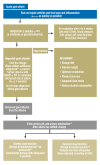Gout--current diagnosis and treatment
- PMID: 19795010
- PMCID: PMC2754667
- DOI: 10.3238/arztebl.2009.0549
Gout--current diagnosis and treatment
Abstract
Background: Because of the changing dietary habits of an aging population, hyperuricemia is frequently found in combination with other metabolic disorders. Longstanding elevation of the serum uric acid level can lead to the deposition of monosodium urate crystals, causing gout (arthritis, urate nephropathy, tophi). In Germany, the prevalence of gouty arthritis is estimated at 1.4%, higher than that of rheumatoid arthritis. There are no German guidelines to date for the treatment of gout. Its current treatment is based largely on expert opinion.
Methods: Selective literature review on the diagnosis and treatment of gout.
Results and conclusions: Asymptomatic hyperuricemia is generally not an indication for pharmacological intervention to lower the uric acid level. When gout is clinically manifest, however, acute treatment of gouty arthritis should be followed by determination of the cause of hyperuricemia, and long-term treatment to lower the uric acid level is usually necessary. The goal of treatment is to diminish the body's stores of uric acid crystal deposits (the intrinsic uric acid pool) and thereby to prevent the inflammatory processes that they cause, which lead to structural alterations. In the long term, serum uric acid levels should be kept below 360 micromol/L (6 mg/dL). The available medications for this purpose are allopurinol and various uricosuric agents, e.g., benzbromarone. There is good evidence to support the treatment of gouty attacks by the timely, short-term use of non-steroidal anti-inflammatory drugs (NSAID), colchicine, and glucocorticosteroids.
Keywords: allopurinol; gout; hyperuricemia,deposits of uric acid; treatment.
Figures



Similar articles
-
Gout: an update.Am Fam Physician. 2007 Sep 15;76(6):801-8. Am Fam Physician. 2007. PMID: 17910294 Review.
-
[Pathogenesis, diagnostics and therapy of gout].Vnitr Lek. 2006 Jul-Aug;52(7-8):736-41. Vnitr Lek. 2006. PMID: 16967617 Review. Czech.
-
Gout Medications.2017 Jul 19. LiverTox: Clinical and Research Information on Drug-Induced Liver Injury [Internet]. Bethesda (MD): National Institute of Diabetes and Digestive and Kidney Diseases; 2012–. 2017 Jul 19. LiverTox: Clinical and Research Information on Drug-Induced Liver Injury [Internet]. Bethesda (MD): National Institute of Diabetes and Digestive and Kidney Diseases; 2012–. PMID: 31643551 Free Books & Documents. Review.
-
Limitations of the Current Standards of Care for Treating Gout and Crystal Deposition in the Primary Care Setting: A Review.Clin Ther. 2017 Feb;39(2):430-441. doi: 10.1016/j.clinthera.2016.12.011. Epub 2017 Jan 11. Clin Ther. 2017. PMID: 28089200 Review.
-
[Hyperuricemia and gout: diagnosis and therapy].Internist (Berl). 2006 May;47(5):509-20; quiz 521. doi: 10.1007/s00108-006-1578-y. Internist (Berl). 2006. PMID: 16586130 German.
Cited by
-
Effect of tea intake on genetic predisposition to gout and uric acid: a Mendelian randomization study.Front Endocrinol (Lausanne). 2024 Feb 2;14:1290731. doi: 10.3389/fendo.2023.1290731. eCollection 2023. Front Endocrinol (Lausanne). 2024. PMID: 38440060 Free PMC article.
-
IL1A regulates the inflammation in gout through the Toll-like receptors pathway.Int J Med Sci. 2024 Jan 1;21(1):188-199. doi: 10.7150/ijms.88447. eCollection 2024. Int J Med Sci. 2024. PMID: 38164346 Free PMC article.
-
Protective effects of corni fructus extract in mice with potassium oxonate-induced hyperuricemia.J Vet Med Sci. 2022 Aug 19;84(8):1134-1141. doi: 10.1292/jvms.21-0671. Epub 2022 Jul 4. J Vet Med Sci. 2022. PMID: 35781421 Free PMC article.
-
The Role of the Intestine in the Development of Hyperuricemia.Front Immunol. 2022 Feb 24;13:845684. doi: 10.3389/fimmu.2022.845684. eCollection 2022. Front Immunol. 2022. PMID: 35281005 Free PMC article. Review.
-
Metal-Assisted and Microwave-Accelerated Decrystallization: An Alternative Approach to Potential Treatment of Crystal Deposition Diseases.Clin Arch Bone Jt Dis. 2017;1(1):10.23937/cabjd-2017/1710002. doi: 10.23937/cabjd-2017/1710002. Epub 2017 Oct 13. Clin Arch Bone Jt Dis. 2017. PMID: 33834175 Free PMC article.
References
-
- Campion EW, Glynn RJ, DeLabry LO. Asymptomatic hyperuricemia. Risks and consequences in the normative aging study. Am J Med. 1987;82:421–426. - PubMed
-
- Choi HK, Atkinson K, Karlson EW, Willett W, Curhan G. Purine-rich foods, dairy and protein intake, and the risk of gout in men. N Engl J Med. 2004;350:1093–1103. - PubMed
-
- Choi HK, Atkinson K, Karlson EW, Willett W, Curhan G. Alcohol intake and risk of incident gout in men: a prospective study. Lancet. 2004;363:1277–1281. - PubMed
Publication types
MeSH terms
LinkOut - more resources
Full Text Sources
Other Literature Sources
Medical


